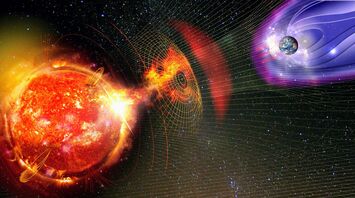Space Weather Forecast Overview: October 7

CME is imminent. G1/G2 conditions are expected, with a chance of G3 over the weekend. R1/R2 activity is anticipated throughout.
Geomagnetic Storm Watch
G3: 15:00 (UTC) on Sat, Oct 5, 2024
Ends: 00:00 (UTC) on Mon, Oct 7, 2024
Analysis of Space Weather Activity Over the Past 24 Hours
Solar Activity:
Solar activity remained high, reflecting the proximity of background flux to Moderate-class levels. Minor increases resulted in low-level Moderate-class X-ray flares rather than extensive Strong-class activity. The most significant flare peaked on Oct 5 at 05:20 UTC, originating from a large, complex sunspot in the southwest. A similar flare occurred at 08:44 UTC from a sunspot region near the eastern solar horizon, although the monitoring imagery quality was diminished during this time.
There are currently seven sunspot groups. Two groups have crossed the western horizon, while a third is fading in the east. The southwest quadrant is still densely populated by large and complex regions. These larger spots have experienced slight consolidation and marginal areal growth. In contrast, changes in the eastern hemisphere have evolved more slowly and restricted.
There is a noteworthy "filament" (an arc of plasma) in the Sun’s south-central region, which should be monitored for potential Coronal Mass Ejections (CMEs) if it destabilizes.
CME Activity:
Most CME activity has been confined to high latitudes above the western horizon without impacting Earth. No new Earth-directed CMEs were noted.
Solar Wind/Geomagnetic Activity:
The anticipated Strong-class flare-related CME from October 3 reached a near-Earth satellite at 19:43 UTC on October 5. The shock is co-aligned with Earth’s magnetic field; however, recent hours have shown variations leading to anti-alignment. This satellite is around 25 degrees ahead of Earth, orbiting at a slightly closer distance. Given the CME source’s central position, its front will likely reach Earth's orbit concurrently.
Solar wind speeds remain relatively slow, with slightly elevated density values within the normal range. The associated magnetic field saw brief peaks but mostly reflected stability. The north-south component fluctuated, lacking any dominant aligned periods with Earth's magnetic field.
The overall measurement of solar wind indicates largely tranquil geomagnetic activity.
Energetic Particles/Solar Radiation
No solar radiation storms have been observed.
Four-Day Space Weather Forecast Summary
Solar Activity:
Moderate to high solar activity is anticipated, with occasional Moderate-class flares expected and some chance of isolated Strong-class flares. While the forecast does not indicate the return of large regions on the eastern horizon, a slow decline in the southwestern quadrant should reduce flare probabilities by midweek.
Solar Wind/Geomagnetic Activity:
The significant CME expected is the impending event from the Strong-class flare on October 3. Following this, glancing impacts from an interaction between a Moderate-class flare and a filament eruption are likely late on October 7.
On Tuesday, October 8, a fast solar wind will arrive. This may resemble enhancements from previous CME effects. The last period of low geomagnetic activity should occur by the end of this four-day forecast, barring any new CMEs.
G1-G2 Minor to Moderate geomagnetic storm conditions are anticipated through the weekend due to effects from the Strong-class CME. A chance for G3 conditions persists, along with a slight possibility for isolated G4 intervals. Geomagnetic activity will likely decrease entering the new UTC workweek, although more G1 activity could arise from close approaches of the Moderate-class CME later on October 7 or minor fast wind on October 8. Each event will likely be less effectual than its predecessor.
Energetic Particles/Solar Radiation:
There is a daily chance of exceeding the S1/Minor Storm threshold, contingent on significant flare activity occurring.



















